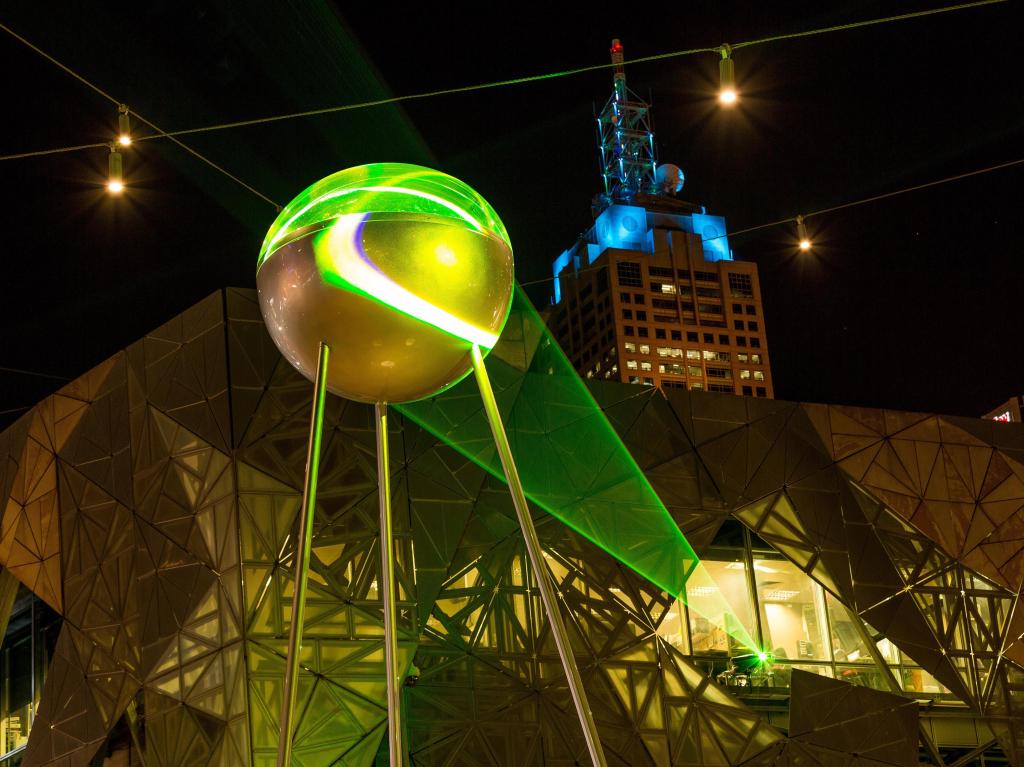Molecule of Light at Fed Square (Image: James Morgan)
The Light in Winter at Fed Square sits at an intersection where artistic excellence meets community. The result is a festival that’s not only diverse but also gets everyone out into the city’s heart.
Matt Jones Program Manager at Fed Square says that the combination of excellence and community appeal is very fundamental to the festival. Under the artistic direction of Robyn Archer AO, who has been directing the program since its inception nine years ago, Jones said that The Light in Winter had benefited from ‘a very sophisticated level of artistic direction that has led to some very unique and high-end artistic outcomes’.
Jones said that art and community cultural expressions are core to the identity of The Light in Winter celebrations.
‘The festival accommodates impressive, world-class artworks alongside richly engaging community expressions and representations and that’s why we think it’s special.’
When The Light in Winter first started in 2007, it was designed to ‘warm up’ and give some life to what Jones describes as ‘a very bleak, empty plaza in the middle of winter’.
Since then Jones said the sense of community ownership of the program has come to define it. ‘It has remarkably grown over the years so that now not only do we have several dozen community groups involved in one way or another, but it’s moved from beyond simple displays of ethnic identity into much more collaborative and integrated programs of art and community involvement.
‘A lot of the individual pieces of programming that will wind up being around the campfire or that will be presented at the Solstice Celebration (which is our signature event) are very much shaped by and sourced through the community rather than it being top-down prescriptions from us.’
This year the festival coincides with the International Year of Light, a source of inspiration that Jones said had shaped the program. This year’s work presents and contrasts two very different light sources.
‘Chris Levine’s Molecule of Light is going to be a laser-based work of art in the middle of The Square. So at one end of the spectrum is one of the most advanced forms of human manipulated light that exists and at the other end there’s Vicki Couzens’ campfire installation, Leempeeyt Weeyn’, which is one of the recurring motifs of the program and has been in existence since the very start,’ said Jones.
Levine’s work is the latest major commission by Fed Square, and one of quite a proud history of Australian and international conceptual lighting and visual artists for the program.’
Levine, a UK artist, takes inspiration from nature and our connectedness to it. The installation stands eight metres above the ground, as lasers converge upon a central acrylic sphere from three different angles. The resultant light forms burst into a series of shapes and colours that shine out into The Square.
‘By using laser in my work I am focusing attention onto light in its purest form – single wavelengths of visible energy. To put one’s gaze on the purity of laser light is in itself a meditative act and I hope that Molecule of Light will ultimately be energising for those who come to see it.
‘Molecule of Light is an extension of my work with the Eden Project, and like the Eden project, a molecule is born out of nature and brings us to the realisation that we are part of nature not apart from it,’ said Levine.
At the other end of the time spectrum, is one of the oldest human-made sources of light: fire.
Leempeeyt Weeyn’ is the campfire created by Vicki Couzens for the inaugural program nine years ago. The campfire burns 24 hours a day and hosts a week of fireside performances and activations from artists like DJ Nurra (James Henry), Rob Bundle, Uncle Larry Walsh, Muma Doesa and more.
Apart from the rich cultural installations and performances this year, the 2015 program will also showcase how science plays its part in the expression of art.
‘This year there are three really interesting talks at Deakin Edge, two of which are being produced by Deakin University the third is by Science in Public for International Year of Light,’ said Jones.
Melbourne’s Skunk Control will show how plants use light at the Fracture Gallery in a fascinating 3D installation, Luminous Intervention.
Jones said that the festival was not just about physical displays of light or an AV spectacle of buzzing lights. ‘It’s about expanding that theme through to enlightenment and ideas sharing, and community and interconnection.’
The Light in Winter is a free public event and will run from 1 – 21 June at Federation Square. For more information, visit the website.
Here is a glimpse of The Light in Winter celebrations from last year.
This is Laser from Federation Square on Vimeo.





